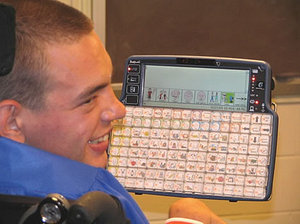Research has proven that augmentative and alternative communication (AAC) devices can serve as a very useful means of communication for those unable to do so through the natural method of speaking or writing. Although many people use such devices, no two are going to be identical, because every AAC device is catered to fit each individual’s specific needs. The implementation of an AAC device is based on an individual’s needs and desires, as well as necessary training for both the AAC user and his or her parents and professionals. There are various matters to consider when implementing such a device into a child’s daily life.
When determining which AAC device would work best for a child, one must first decide whether that child will benefit most from an aided or unaided device. An unaided device involves techniques that do not require the use of an external object to help one communicate. This includes things such as non-linguistics or communication through the body, natural gestures, sign language, cued speech, body signals, vocalizations, and paralinguistics. On the other hand, an aided device involves using some form of an external system to communicate. This system can either be high-tech or low-tech. A high-tech system includes some type of computer based component, while a low-tech system lacks this, and instead includes things such as picture boards or other various objects that a child can access by touching with a finger, using eye gaze, or using a pointer stick.
After these initial decisions are made, if the IEP (Individualized Education Program) team has come to the decision that an aided system would best suit the child’s needs, then they must decide how the symbols will be represented and how the symbols will be organized on the device. They must also determine which type of selection technique the child will use to access and use the device, what vocabulary would be most appropriate to incorporate into the device, and the type of output and feedback the system will provide the child and his or her communicative partners.
All of these factors must be taken very seriously when implementing an AAC device into a child’s life. While one child may benefit from one type of system, another child may not benefit at all based on his or her conditions and/or resources. For example, a child with Early Expressive language Disorder or hearing impairments with no other problems would most likely benefit from an unaided device such as ASL (American Sign Language). This is due to the fact that they do not have motor problems and are not cognitively impaired, and therefore, can handle this type of system. Contrastively, children with mental retardation can have a very low cognitive functioning and may be much more successful with static visual pictures that will not disappear on them. A child with severe fine motor disabilities may do well with a large button attached to a computer and a single switch scanning method of accessing the program. This way, they can allow the computer program to scan through the different vocabulary items stored in their system and then simply hit the large switch when it comes to the idea they want to express
Given these three examples, it is clear that AAC devices can be quite diverse and unique based on the needs of the client. The IEP team must be very open and aware of all the different factors to consider and available methods to successfully implement an AAC system for each unique individual.
Augmentative alternative communication requires much planning and careful consideration in order for it to successfully and fully benefit a child’s communication needs. Once the proper method and device is chosen for a child, it is vital that the device allows the child to take advantage of every situation and environment he or she encounters. Careful monitoring and updates are necessary to allow this to take place, but as long as this occurs, AAC devices are a very effective intervention. They enable people who normally would not be able to communicate with others express themselves through various means.
In order for these devices to be fully effective though, it is important that parents and professionals, especially teachers, learn how to use it as well. The child will spend much time learning in a classroom under the guidance of his or her teacher and surrounded by peers. Therefore, teachers should make every effort to fully learn how to use the device and implement it into their instruction. They should also explain the device to the rest of the class so that the class as a whole can understand the it and communicate with the AAC user.
Unfortunately, the use of AAC devices at home and in school is often inconsistent, and this can lead to problems and confusion between the child and his or her communication partners. If the child is using the device in a particular way at home and then goes to school and none of the same rules apply, this will confuse and frustrate the child and only lead to communication breakdowns and an increase of tension. Therefore, it is essential that teachers and parents communicate and follow the same instructions for the device. Teachers are a significant component of the child’s learning process, so in order to effectively teach the child, they must first learn to properly use the AAC device, which the child depends on to communicate and learn. Consequently, more research should be done to effectively guide teachers in the right direction.
The more aware others become of augmentative and alternative communication, the easier and more productive AAC use will become for its consumers. The only way this is possible is if the public takes time to research, listen, and learn about such devices. There are many valid websites, books, scholarly journals, and articles available to the public. There are also many schools with children who currently use AAC devices. The best way to learn about something is to actually experience it, so going to a school and directly observing a student interacting with others via their AAC device is also an option. Overall, the foundation of successful AAC use is awareness. The more people that know how to interact with a child using such a device, the more benefits the child will encounter.
References:
Angell, M., Bailey, R., Carroll, K., Parette, H., & Stoner, J. (2006). Family Members’
Perceptions of Augmentative and Alternative Communication Device Use.
Language, Speech, and Hearing Services in Schools. 37i>, 50-60.
Beukelman, D., & Mirenda, P. (1998). Augmentative and Alternative Communication:
Management of Severe Communication Disorders in Children and Adults.
Sinteff, Beth (1998).Vocabulary Selection Methods: Update ’98.




